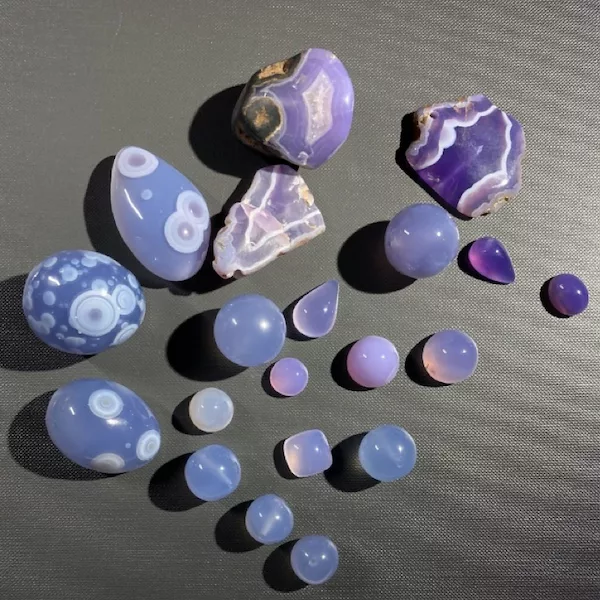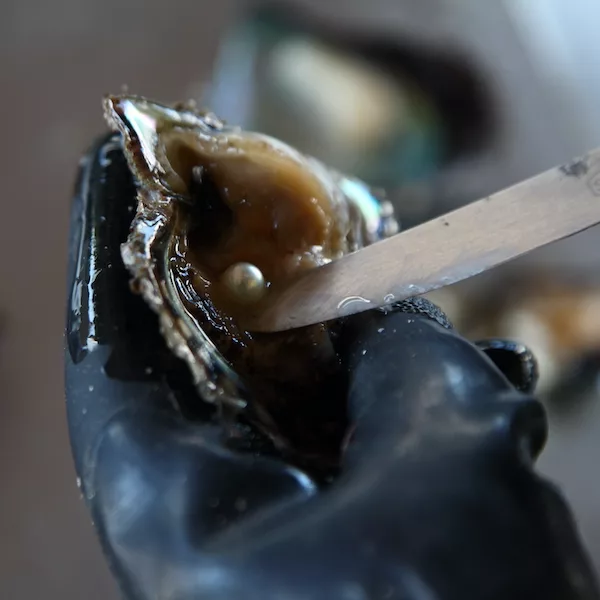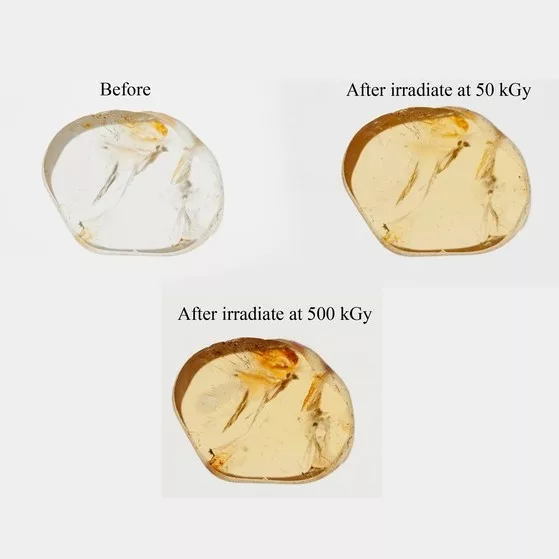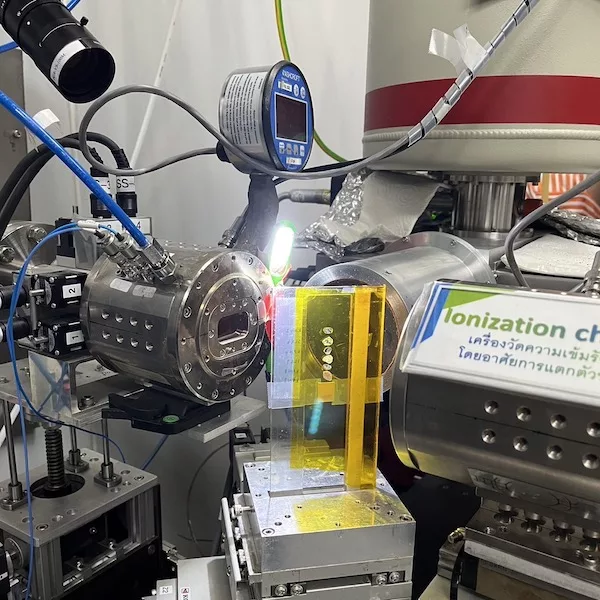Purple to bluish grey chalcedony from Ethiopia
Introduction
In the past 15 years, Ethiopia has repeatedly gained attention for a variety of new gem finds. In 2008, a large deposit of white play-of-colour opal was found (Rondeau et al., 2010), followed by black opal with play-of-colour in 2013 (Kiefert et al., 2014). Both deposits were located in the north of the country near the town of Lalibela. In 2016, high-quality emeralds were recovered from southern Ethiopia (Renfro et al., 2017; Schollenbruch et al., 2017). In the same year, significant deposits of basaltic blue sapphires were discovered in the country’s north (Bruce-Lockhart, 2017). Besides these, other gem deposits, such as sunstone, have been discovered in the Afar region in north-Eastern Ethiopia (Kiefert et al., 2019). In 2019, yet another gemstone deposit was discovered in Ethiopia, this time blue to purple chalcedony partly with an extraordinary saturated colour (Figure 1), which was introduced at the Tucson Gem show in 2022 (see also Furuya, 2022).
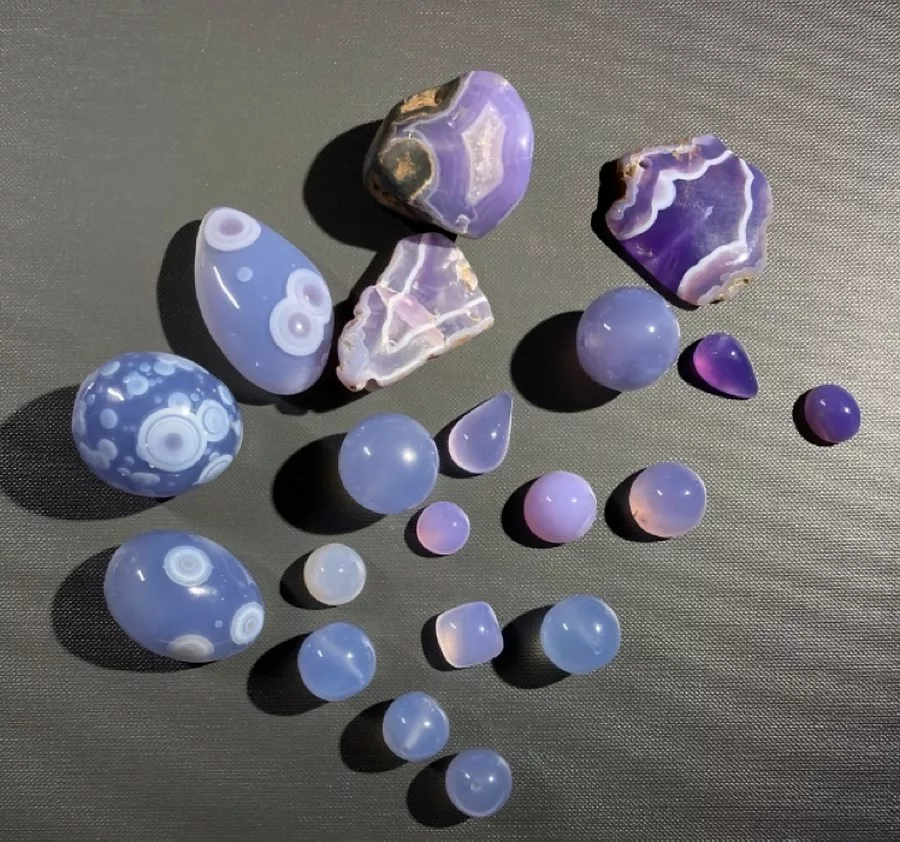
The deposit is located approximately 550 km southwest of Addis Ababa in the southwestern part of Ethiopia. The mining site is situated in the area between the provincial towns of Garda Marta, Kamba, and Gerese. The chalcedonies are found either loose as rough fragments and pebbles in sediment or at the flanks of hills. When the material was introduced in Tucson in 2022, it immediately caught attention by many gem dealers, but questions also arose about colour authenticity and colour stability. We then decided to study the material in detail and performed all the necessary analyses.
Materials and methods
Figure 1 shows the samples collected in Tucson in 2022. Additional samples were acquired at the Tucson Show in February 2023. One of the authors had a dyed chalcedony of unknown origin showing nearly the same colour which was included in this study for comparison. All samples were studied with the microscope. On two of the samples we performed a colour stability test by wrapping half of the chalcedony in aluminium foil and exposing the stone to LW UV light for 5 hours. Two more samples were placed in sunlight for 3 days. In addition, we analysed selected samples by UV-Vis absorption spectroscopy, infrared spectroscopy (FTIR), Raman spectroscopy, and for chemical data by EDXRF.
Preliminary results and discussion
These new chalcedonies from Ethiopia range in colour from pale blue to saturated purple. As rough fragments, these chalcedonies often show white banding (agate), partly also in globular circles, and often also Fe-rich brownish specks and patches. By careful cutting, it is possible to produce either cabochons of very homogeneous colour (pale blue to deep purple) or polished stones with attractive banded and globular patterns (see Figure 1). Careful examination of the samples under the microscope revealed a closed surface with no colour concentrations in grooves and cracks. In comparison, the dyed chalcedony of unknown origin showed evident colour concentrations along cracks and grain boundaries. Under high magnification (200-500x), the surface of the purple chalcedony showed a slight granular “orange peel” effect, whereas the bluish grey chalcedony from the same source was perfectly polished and shiny. Inside the purple chalcedony, we observed clouds of tiny dark particles and small spherical orange spots (probably Fe-hydroxide).
The samples that were placed in the UV light as well as the samples that were placed in sunlight did not show any change in colour. This confirmed the colour of the samples to be natural and stable under normal conditions. UV-Vis spectra of selected samples showed a uniform broad absorption band at about 540 nm for the purple samples, with the height of this band being correlated to the purple colour saturation. In contrast to this, the bluish grey sample was characterized by a broad flat shoulder extending from about 590 nm towards UV, with a small band at about 380 nm. This additional shoulder was not observed in the absorption edge of our purple samples (Figure 2).
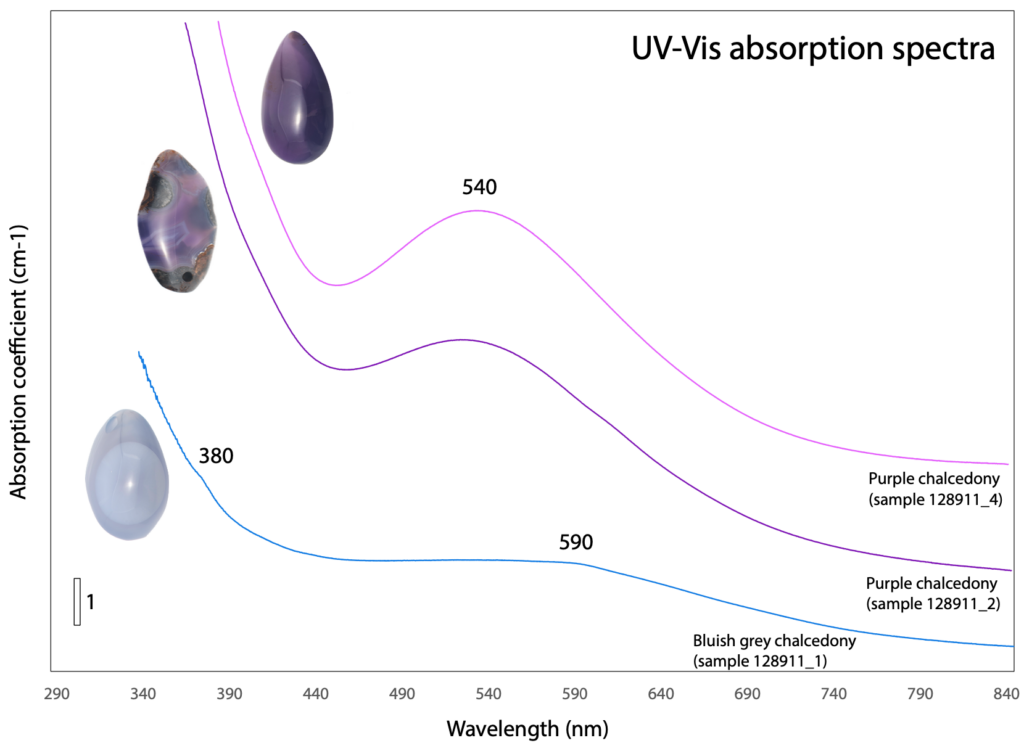
Raman analyses reveal that our samples consist mainly of chalcedony, with minor amounts of moganite (main peak at 501 cm-1), a monoclinic silica polymorph commonly associated with chalcedony and chert (Kingma & Hemley, 1994). Interestingly, the bluish grey chalcedony from Ethiopia contains distinctly higher amount of moganite (approx. 30-40%, see Schmidt et al. 2013) than the purple chalcedony from the same deposit (see Figure 3).
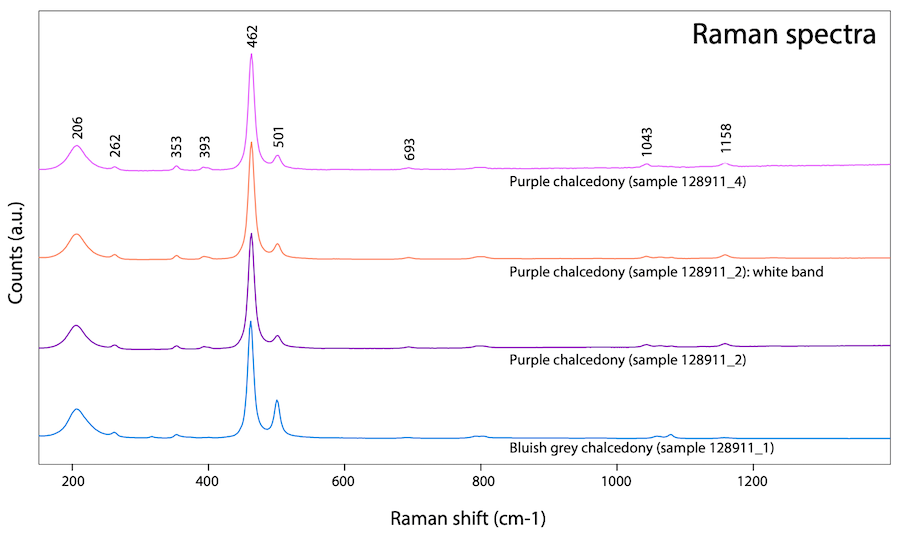
Chemical analyses using EDXRF of a homogenous purple chalcedony showed mainly SiO2 , with low concentrations of Fe (0.20 wt% Fe2 O3 ). Since these chalcedonies occasionally contain small orange inclusions, it is assumed that this iron concentration is representing iron hydroxides rather than substitution for Si in the quartz crystallites of the chalcedony.
Conclusions
Pale bluish grey to saturated purple chalcedony from Ethiopia is yet another sign of the wealth of gems in this country. Various tests led to the conclusion that the colour is natural and stable. No specific trace element was found to explain the saturated purple colour in these samples (see also Renfro & Challener 2019). Based on the close similarity of the absorption spectrum of amethyst and our purple chalcedony samples, we assume that the colour is due to natural irradiation and activation of similar colour centres as in amethyst and thus related to iron impurities in their crystal structure (Shigley & Koivula, 1985; Henn & Schultz-Güttler, 2012).
References:
- Bruce-Lockhart, S., 2017. The Forbidden Road to Chila. Gems & Jewellery, 26 (3), 10-12.
- Furuya, M., 2022. Purple Chalcedony from Ethiopia. Japan Germany Gemmological Laboratory Gem Information, 49, 1-2.
- Henn, U. & Schultz-Güttler, R.A., 2012. Review of some current coloured quartz varieties. J. Gemm., 33 (1-4), 29-43.
- Kiefert, L., Hardy, P., Sintayehu, T., Abate, B. & Woldetinsae, G., 2014. New deposit of black opal from Ethiopia. Gems & Gemology, 50 (4), 303-305.
- Kiefert, L., Wang, C., Sintayehu, T. & Link, K., 2019. Sunstone Labradorite-Bytownite from Ethiopia. – J. Gemm., Gem Notes, 36 (8), 694-696.
- Kingma, K.J. & Hemley, R.J., 1994. Raman spectroscopic study of microcrystalline silica. American Mineralogist, 79, 269-273.
- Renfro, N. & Challener, S., 2019. Native copper inclusions in Indonesian purple chalcedony. Gems & Gemology, 55 (1), 111.
- Renfro, N., Sun, Z., Nemeth, M., Vertriest, W., Raynaud, V. & Weeramonkhonlert, V., 2017. A new discovery of emeralds from Ethiopia. Gems & Gemology, 53 (1), 114-116.
- Rondeau, B., Fritsch, E., Mazzero, F., Gauthier, J.-P., Cenki-Tok, B., Bekele, E. & Gaillou, E., 2010. Play-of-Color Opal from Wegel Tena, Wollo Province, Ethiopia. Gems & Gemology, 46 (2), 90-105.
- Schmidt, P., Bellot-Gurlet, L., Léa, V., & Sciau, P., 2013. Moganite detection in silica rocks using Raman and infrared spectroscopy. European Journal of Mineralogy, 25 (5), 797-805.
- Schollenbruch, K., Link, K. & Sintayehu, T., 2017. Gem Quality Emeralds from Southern Ethiopia. InColor, Issue 35, 48-50.
- Shigley, J.E. & Koivula, J.I., 1985. Amethystine Chalcedony. Gems & Gemology 21 (4), 219-223.

